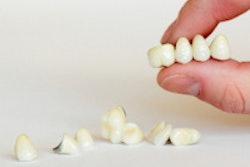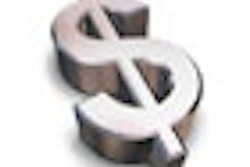
2010 is turning out to be a banner year for dental CAD/CAM. And it looks like it's only the beginning.
Sirona Dental Systems, currently the market leader with 27,000 installed Cerec systems, reported a 37.5% jump in CAD/CAM sales in the first quarter -- most of it from new systems sales, not upgrades, according to President and CEO Jost Fischer.
Sirona's not alone. Straumann reported net profits of $137 million in fiscal 2009 (end-December 31), compared to $7.5 million in fiscal 2008. And at the recent Chicago Midwinter Meeting, the company was touting a new "digital restorative workflow" platform created to streamline the design and milling process. In addition, Straumann is partnering with Cadent and Ivoclar Vivadent to further expand its reach in this market, serving as the exclusive European distributor for Cadent's iTero system and adding Ivoclar's new IPS e.max restorative materials to its product offerings.
Meanwhile, D4D Technologies -- which is not a public company so does not disclose its financials -- continues to see expansion of its business, according to Gary Severance, D.D.S., vice president of marketing and clinical affairs. The company has key relationships with Henry Schein, Ivoclar, and 3M ESPE that further broaden its market presence, and is gearing up to launch some CAD/CAM enhancements this year.
Market drivers
So what is driving all this growth? It depends on who you talk to, but one thing is certain -- the future is now, according to Richard Steinberg, D.D.S., president of the Academy of CAD/CAM Dentistry.
"CAD/CAM is definitely here, and it is probably one of the greatest advances there has ever been in dentistry," he said.
Dr. Severance attributes the current market growth to a convergence of three factors: more computing power, advances in dental materials (notably all-ceramics), and the rocky economy.
"CAD/CAM is at a crossroads," he said. "The ability to handle large files and communicate between different offices and people didn't exist before. Also, the materials have evolved. And patients are looking for cost-effective and time-efficient ways to take care of their health. So this is a great time to be able to offer this."
From Straumann's perspective, dental labs have long been a key market driver for CAD/CAM.
"Dental labs have invested more in CAD/CAM than the dentists themselves," said Martin Dymek, regional head of North America for Straumann. "So they are increasingly the ones communicating the advantages of CAD/CAM to their dentist customers."
Overcoming fears
In recent years, the emphasis for many CAD/CAM vendors has shifted to the dentists. The benefits of in-office milling for the dental practice include higher productivity and high-quality, all-ceramic restorations that are biocompatible, tooth-colored, and long-lasting, according to John Sweeney, director of investor relations for Sirona.
"And from an economics point of view, dentists can make money using an in-office CAD/CAM system," he said. "It saves lab fees, and it also saves time. A good digital impression is more accurate and requires less rework."
Still, CAD/CAM is not for every dentist, Severance noted. "Digital dentistry is, but not CAD/CAM," he said. In fact, according to Sweeney, only 11% of the dental offices in the U.S. have invested in Cerec systems.
“CAD/CAM ... is probably one of the greatest advances there has ever been in dentistry.”
— Richard Steinberg, D.D.S., president
of the Academy of CAD/CAM
Dentistry
"The question always is why haven't the other 90% adopted this?" he said. "We think technology is a hurdle. Not all dentists have computers, and some fear they may not be able to use the technology. So making it easier to use is key -- automating the process and speeding the process."
All three companies are pushing forward with new products and applications that should help reach customers who so far have shied away from CAD/CAM. D4D, for example, has developed the E4D Flash, a desktop digital scanner for dentists who want to take conventional impressions, digitize them, and then send them to the lab, Severance said. It will be available this summer.
"This is for dentists who hesitate to make changes in the patient's treatment," he said. "They can do everything they do the same, but transport it differently for designing and milling."
And later this year D4D will introduce the E4D Solo, for dentists who want to do scans but not milling, preferring instead to send the scans out to a lab, Severance said. Another new product is the E4D Skyway, which digitally links all these systems for easier data and image sharing.
Further out, the company is looking at integrating optical coherence tomography, an advanced imaging technique, with its CAD/CAM system to eliminate the need to retract tissue to see the margins.
"The goal is, in two years' time, at the same time you are scanning the tooth for the restorative, in one second you can get a full diagnostic image of the tooth. One scan would do everything. That is where we are headed," Severance said.
Expanding applications
Meanwhile, Sirona recently demonstrated the latest version of its biogeneric software for the Cerec, which enables dentists to design and fabricate inlays, onlays, crowns, veneers, and bridges using a patient's intact tooth morphology rather than stock images. The company is also focused on implant planning, which combines CAD/CAM with diagnostic imaging, Sweeney said.
"We are starting to see the integration of CAD/CAM with 3D diagnostic tools like the Galileos [Sirona's cone-beam CT system]," he said. "So now dentists can take a 3D scan and then look at the bone information and make sure everything is properly aligned. Then they can create drilling templates, crowns, abutment connectors, etc. And we are starting to see this happen for implants as well."
Sirona has been steadily working to extend its reach into the lab market as well, claiming 4,400 installed systems worldwide, Sweeney said. The most recent addition to the inLab product line is the inEos Blue scanner, which uses short-wavelength blue light to produce more precise images, according to the company.
"A key thing for us is innovation," he said. "We invest $40 million to $50 million annually in R&D, and we've got over 200 engineers and scientists developing products that are going to drive forward CAD/CAM and our other businesses."
Despite all the emphasis on in-office milling, Straumann has opted to bypass this part of the market and focus instead on providing a digital platform that makes it easier for the dentist to work with the design lab and milling facility, according to Dymek. Digital images are acquired using the iTero system, which is integrated with the Straumann CAD system for lab design. Those images are then sent to the Straumann CAM mills for coping, framework, and restoration. Alternatively, the dentist can choose to have the models fabricated at Cadent and shipped to the Straumann facility.
This approach gives dentists a different set of advantages, according to Dymek: higher-quality restorations and more chairside time with patients. Straumann customers do not buy milling machines, he noted; rather, they send their digital files to the company's centralized lab and milling facility in Texas.
"In the typical dental practice, with in-office milling you get a very compromised view of what a milling machine can be," Dymek said. "The milling accuracy and predictability won't be anywhere near what we can offer at our facilities. You cannot fabricate restorations at the same level in the dental office compared to what you can do in an industrial environment."
As the dental CAD/CAM market continues to mature and the products improve, it may be time to look more closely at how this tool could benefit your practice.
"Some dentists poo-poo CAD/CAM and don't even want to think about it," Severance said. "But dentistry can certainly win and gain incredible production by embracing technology rather than resisting it."
Copyright © 2010 DrBicuspid.com



















